- All Exams Instant Download
In a converged access deployment, which two statements about mobility agents are true? (Choose two.)
In a converged access deployment, which two statements about mobility agents are true? (Choose two.)
A . It maintains a client database of locally served clients.
B . It manages mobility-related configuration.
C . It handles RF functions.
D . It is the first level in the converged access hierarchy.
E . It is a mandatory element in the converged access design.
Answer: AD
Explanation:
From: CT5760 Controller Deployment Guide -Mobility Architecture [Cisco 5700 Series Wireless LAN Controllers] -Cisco http://www.cisco.com/c/en/us/td/docs/wireless/technology/5760_deploy/ CT5760_Controller_Deployment_Guide/Mobility_Architecture.html
Here are the mobility components in the new mobility architecture:
Mobility Agent
A mobility agent manages AP connectivity, CAPWAP tunnel terminations from APs and builds a database of client stations (endpoints) that are served locally as well as roamed from an Anchor WLC. Mobility agent can be either a Catalyst 3850 or a CT5760 mobility controller with an internal mobility agent running on it.
Mobility Controller:
A mobility controller provides mobility management tasks including inter-SPG roaming, RRM, and guest access. Mobility roaming, where a wireless client moves from one physical location to another without losing connectivity and services at any time, can be managed by a single mobility controller if roaming is limited to a mobility sub-domain. Roaming beyond a mobility sub-domain can be managed by multiple mobility controllers in a mobility group. The mobility controller is responsible for caching the Pairwise Master Key (PMK) of all clients on all the mobility controllers, enabling fast roaming of the clients within its sub-domain and mobility group. All the mobility agents in the sub-domain form CAPWAP mobility tunnels to the mobility controller and report local and roamed client states to the mobility controller. The mobility controller builds a database of client stations across all the mobility agents.
Mobility Oracle
Mobility oracle further enhances mobility scalability and performance by coordinating roaming activities among multiple mobility groups, which removes the need for N2 communications between mobility controllers in different mobility groups to improve efficiency and performance.
Mobility Group
The mobility group is a logical group of mobility controllers to enable fast roaming of clients within the mobility controllers of a mobility group.
Mobility Sub-domain
Multiple SPGs can be grouped together and collectively managed as a mobility sub-domain. One mobility controller is required for each mobility sub-domain.
Switch Peer Group
The Converged Access deployment defines an SPG as a logical group of mobility agents within one mobility controller (or mobility sub-domain). The main advantage of configuring SPGs is to constrain the roaming traffic to switches that form the SPG. When the mobility agents are configured in one SPG on the mobility controller, the software automatically forms full mesh CAPWAP tunnels between the mobility agent switches. These CAPWAP tunnels can be formed in a multi-layer network design (where the mobility agent switches are L2 adjacent on a VLAN spanned across) or a routed access design (where the mobility agent switches are L3 adjacent). The SPGs should be designed as a group of mobility agent switches to where the users frequently roam.

Latest 400-351 Dumps Valid Version with 192 Q&As
Latest And Valid Q&A | Instant Download | Once Fail, Full Refund
Subscribe
Login
0 Comments
Inline Feedbacks
View all comments

